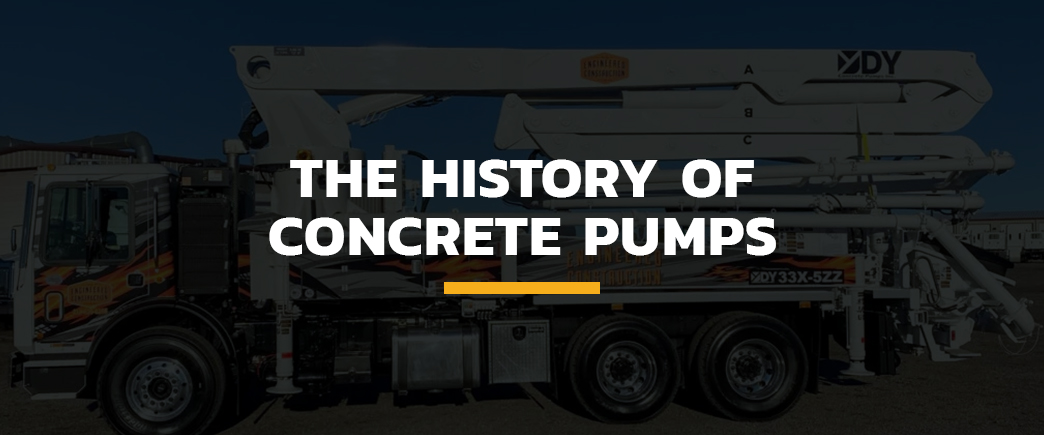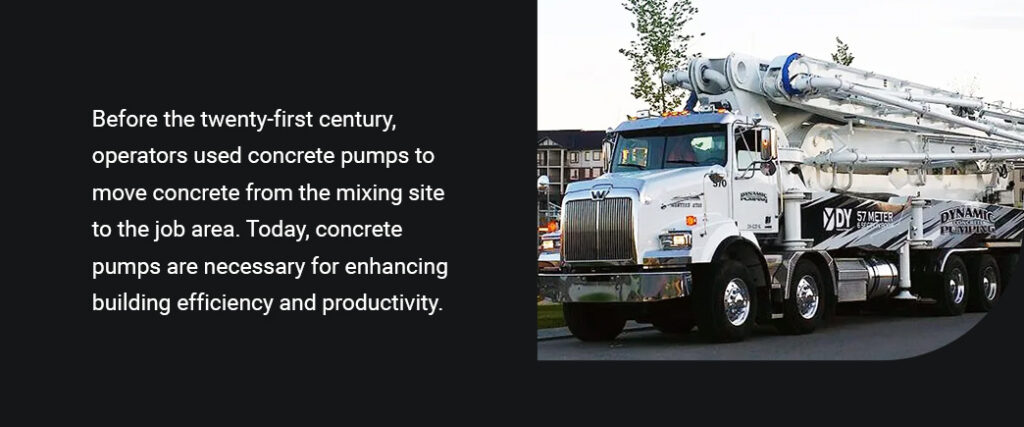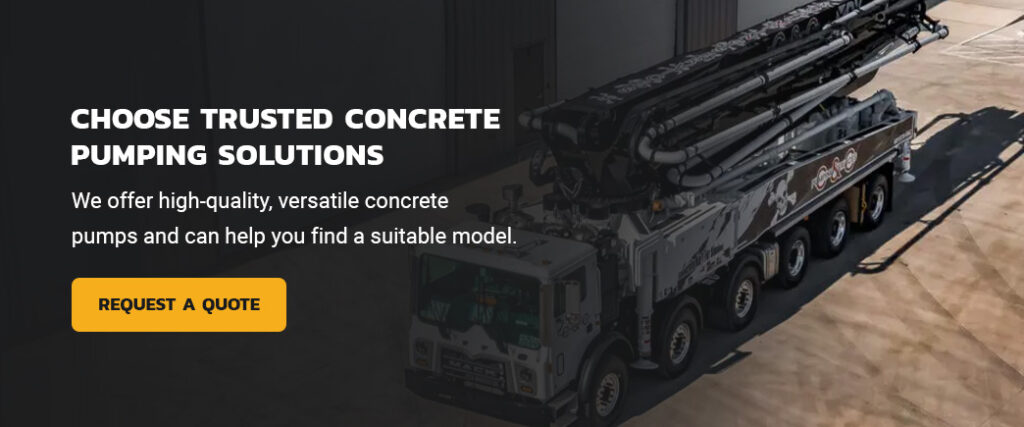The History of Concrete Pumps
Posted On: 02/07/2024 | Posted by: DY Concrete Pumps

Twentieth-century construction sites were strenuous. Working on projects required long hours, hard work and skill, especially when hauling heavy concrete loads on challenging terrains and in harsh conditions. The invention of concrete pumps changed the construction industry, helped improve project efficiency and, most of all, helped mitigate some of the laborious work.
Concrete pumps continued to evolve throughout the years. And, with every advancement, they improved construction jobs and working conditions. Modern concrete pumps offer comprehensive and innovative features, functionality and safety components.
Understanding where concrete pumps began and what they look like now will give you a greater appreciation for those who operate them, the manufacturers who work tirelessly to transform these tools and those before them.
History of a Concrete Pump
Concrete pumps’ history is long and exciting. Did you know construction workers transported and offloaded concrete using a wheelbarrow before large concrete pumps? They pushed wheelbarrows filled with concrete from the mixing site to the placement area, even if it meant walking long distances through narrow paths and high platforms. Thanks to modern innovation, concrete pumps are far more advanced than a wheelbarrow.
Before discovering how they have evolved over the years, let’s start at the beginning. Here’s a brief history of concrete pumps and their design milestones:
Early Twentieth Century
Builders transported the liquid concrete mixture to wheelbarrows from mixers. This process was long and labor-intensive. Builders also used buckets or a skip grew to hoist concrete up to high buildings, which is time-consuming and requires many load lifts. As time progressed, construction industries used cranes to lift buckets with concrete to high construction sites.
1927
German engineers Max Giese and Fritz Hull developed the concrete pump mechanism. The system worked by moving concrete via a series of pipes until it reached the job site. It was more efficient and pioneered several different pump designs and varieties over this period.
1957
German engineer Friedrich Wilhelm Schwing manufactured the most significant early milestone in concrete pump innovation. The twin-cylinder hydraulic concrete pump moved concrete straight from the hopper to the job site. The design could pump and transport concrete faster and in higher quantities consistently to various job sites, including high-rise building sites. Companies made various advancements to twin-cylinder hydraulic concrete pumps, providing faster and more efficient solutions than twenty-first-century modern variations.
Twenty-First Century
Modern pumps have hoses that permit precise concrete placements at the site wherever its placement. They also provide consistent concrete flow and hoist buckets quickly, speeding up processes. Contractors use ready-made concrete, and builders can set down concrete via a concrete boom pump. Today, manufacturers develop multiple pump varieties with advanced functionalities to support small and large-scale jobs.

Concrete Pump Applications Then and Now
Before the twenty-first century, operators used concrete pumps to move concrete from the mixing site to the job area. The applications included pulling concrete from the hopper and lifting it to large or high building sites. The uses of concrete pumps evolved and are significant tools for multiple infrastructures and industries like bridges and dams, sidewalks, highway overpasses and tunnels, high-rise buildings, hydro architecture, railways and airports.
Today, concrete pumps are necessary for enhancing building efficiency and productivity. We use them for many of the same purposes as we always have, but the process is faster and simplified.
Evolution of Concrete Pumps
Concrete pump designs have evolved, offering safer, more efficient and versatile pumping.
Range
The evolution of concrete pumping includes numerous pump types for unique functions. Here are some common varieties:
- Stationary concrete pumps: These pumps have long pipelines to transport concrete from a fixed position to various sites. They can be ideal for laying foundations and concrete slabs.
- Trailer concrete pumps: Contractors use these pumps for maneuvering through narrow spaces and are suitable for small-scale jobs like pouring concrete for a residential swimming pool.
- Truck-mounted boom concrete pumps: These tools have boom pumps for reaching high, limited areas and can work great for heavy work like pumping concrete to high-rise real estate buildings and construction sites.
- Truck-mounted static booms: This pump is mounted on the back of trucks for better accessibility to project locations like large construction sites.
Safety
Workers faced various safety hazards when manually transporting concrete on job sites. They were exposed to other heavy equipment, which could cause harm and injury. Buckets with concrete could also be unstable and collapse on workers. Modern concrete pumps have advanced safety features like outrigger pads to stabilize equipment when lifting or transporting loads. They also have pump covers to absorb impact from pressure blowouts. Some pumps have a computer-aided system that helps operators monitor faults and diagnose issues.
Functionality
While the first pumps offered accurate pumping, today’s models have even greater functionality. Modern concrete pumps can have extended booms and cylinders to reach narrow and high areas. S-valve components enable maximum or high-pressure pumping and help operators manage pumping pressures.
Efficiency
While the older twentieth-century pumps could reach higher sites, advanced concrete pumps can provide extensive carrying capacities. With capacities like 100 to 150-meter pipelines, operators can speed up the delivery of concrete placement to short and long-distance sites, improving productivity and efficiency.
Durability
Harsh or coarse concrete can wear pumping tubes and require repairs and replacements. Older concrete pumping modes had less rigid steel, making them more susceptible to wear. Today, concrete pumps can have S-tubes with reinforced and resistant steel parts to withstand difficult or dense concrete. Rigid pumps can last longer and be more economical in the long run.
Maneuverability
Concrete pumps are available in different sizes, providing more options for multiple applications. While other varieties were available from the 1950s, modern-day concrete pumps are more focused. You can get smaller trailer pumps for minor jobs and big truck-mounted pumps for heavy-duty jobs. Construction companies and contractors can select the best concrete pump type and model to meet their objectives.
Accessories
Today’s concrete pumps have numerous accessories that make pumping more convenient. Concrete pumps can have side storage storing away panels for nearly stewing away pump components. They can have water tanks for high-pressure cleaning, helping operators easily clean and maintain their pump equipment. Larger pumps like truck-mounted boom and static pumps can have air tanks and compressors for cleaning pipelines. Concrete pumps can also have extended hoses for reaching far, high and narrow areas.
Choose Trusted Concrete Pumping Solutions
Construction jobs are unique — you must navigate various heights and distances effectively to enhance production. Using innovative concrete pumps is essential for maximizing efficiency and staying competitive.
We understand the importance of advanced concrete solutions at DY Concrete Pumps to meet evolving constructing landscapes. For years, we have been pioneering concrete manufacturing to keep up with demands. We continue to reinvent the wheel to produce state-of-the-art pumping solutions.
We offer high-quality, versatile concrete pumps and can help you find a suitable model. Contact us to request a quote for your concrete pump.


 1-844-397-8677
1-844-397-8677



